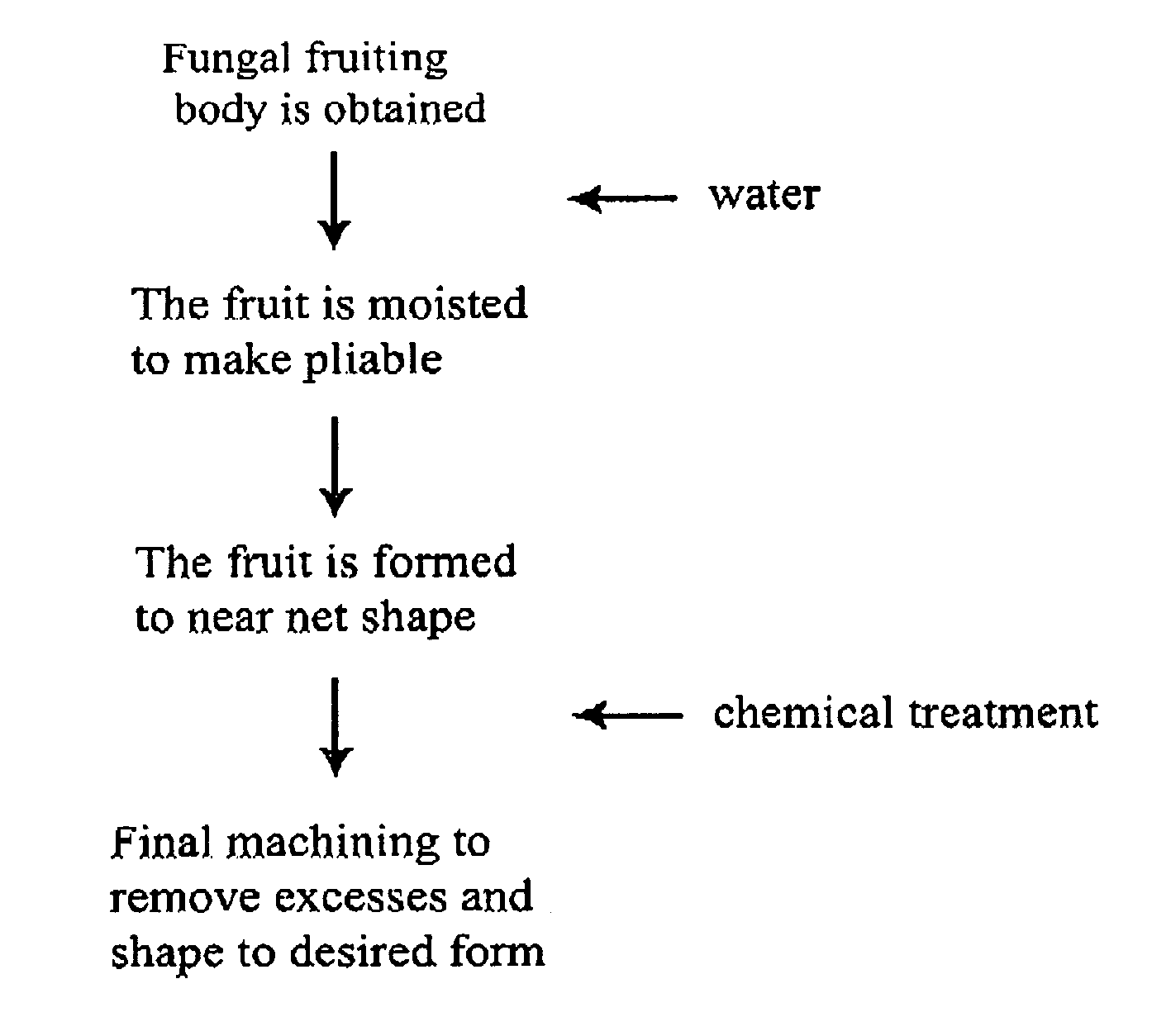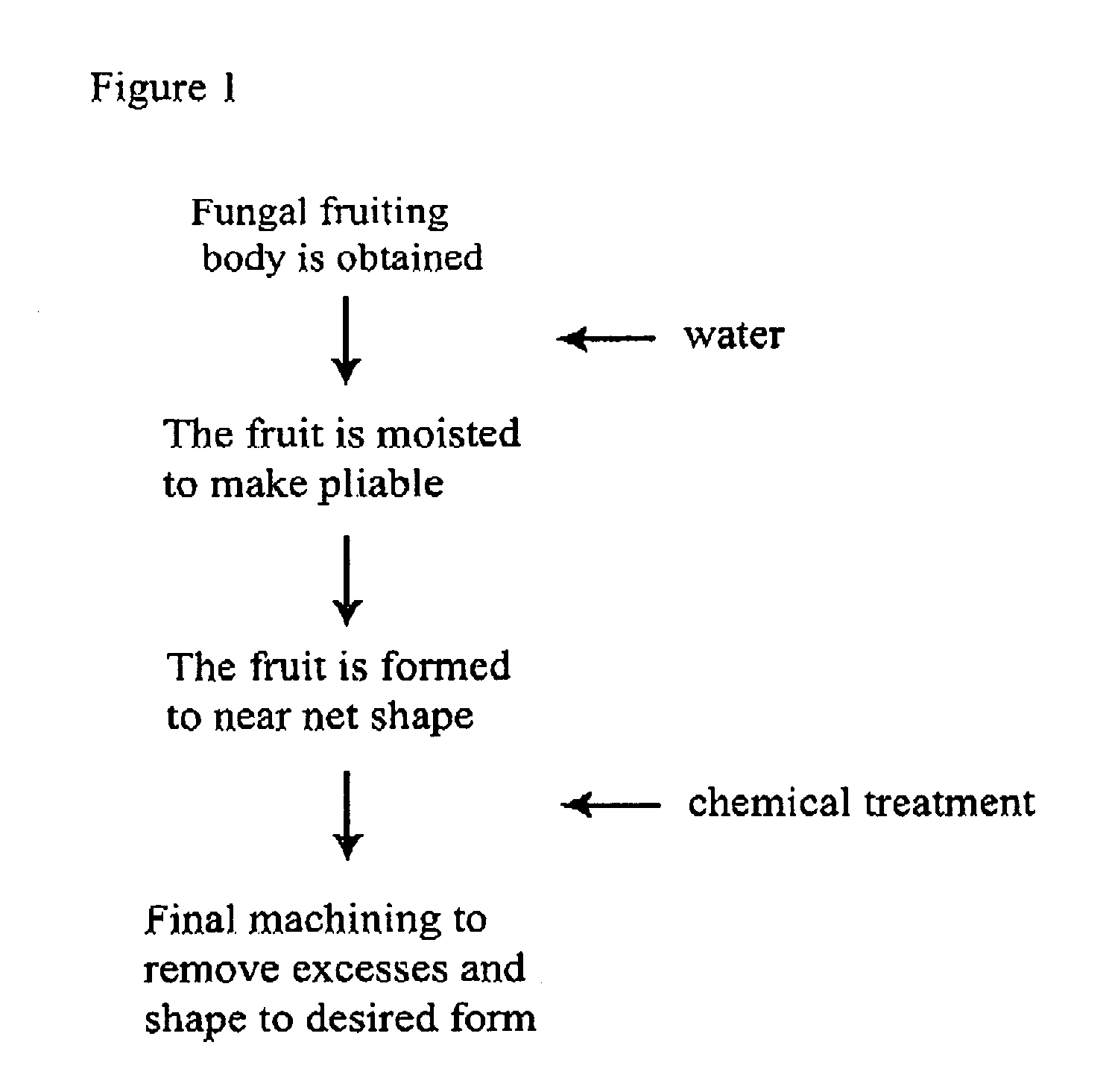Method for producing rapidly renewable chitinous material using fungal fruiting bodies and product made thereby
a technology of fungal fruiting bodies and chitinous materials, which is applied in the field of rapid renewable chitinous materials using fungal fruiting bodies and products made thereby, can solve the problems of long post-use lifespan, high cost of such materials, and many homogenous materials and composites producing significant environmental downsides, so as to influence growth speed, prevent spore emission, and influence the dispersion
- Summary
- Abstract
- Description
- Claims
- Application Information
AI Technical Summary
Benefits of technology
Problems solved by technology
Method used
Image
Examples
example 2
Grown Fruiting Body
[0094]Dryad's Saddle (Polyporus squamosus) was cultured on a substrate comprised of 75% waste cotton burrs from the USDA located in Lubbock Tex. and 24% cottonseed hulls from Planters Cotton Mill in Arkansas. The substrate was buffered with 1% gypsum and was mixed at a 100% moisture content. The cottonseed hulls and cotton burrs were sterilized by soaking in a 35% hydrogen peroxide solution for 25 minutes. The gypsum, cotton burrs, and cotton seed hulls, were than poured into 5 cubic foot flexible opaque bags with breathable membranes and inoculated using 2 liters of liquid inoculum. Bags were incubated for 45 days at 21 degrees Celsius.
[0095]Referring to FIG. 7, small punctures, with a diameter of approximately 0.125″were created every 12″ along a 12″×12″ grid creating a series of orifices 3 along a set of grid lines 9.
[0096]Referring to FIG. 8, An enclosure 4, sized 2″×12″×24″, was placed over the series of orifices and firmly affixed to the flexible incubation ...
example 3
Grown Fruiting Body
[0099]Dryad's Saddle (P. squamosus) was cultured on substrate comprised of 75% waste sugar maple sawdust from New Morning Farm in Bethel, Vt. and 24% cottonseed hulls from Planters Cotton Mill in Arkansas. The substrate was buffered with 1% gypsum and was mixed at a 100% moisture content. The cottonseed hulls and cotton burrs were sterilized by autoclaving for 1 hour at 15 PSI. The gypsum, cotton burrs, and cotton seed hulls, were allowed to cool to room temperature, and than poured into 5 cubic foot flexible opaque bags with breathable membranes and inoculated using 2 liters of liquid inoculum. Bags were incubated for 45 days at 21 degrees Celsius.
[0100]FIG. 10 shows a flexible incubation bag 1 after 45 days of incubation. Small punctures, with a diameter of approximately 0.125″ were created every 12″ along a 12″×12″ grid creating a puncture point 2, a puncture point 2b, and a puncture point 2c, additional puncture points are not pictured.
[0101]FIG. 11 shows a pr...
example 4
Static Embodiment Structural Core
[0105]FIG. 14 shows the mass of fungal tissue from example 3, i.e. a finished fungal part 8, laminated between two sheets of a stiff veneer 9 comprised of ⅛″ thick plywood purchased from The Home Depot in Latham, N.Y. This laminate construction could then be used as a light weight panel in a vehicle, as a table top, as a blade component in a wind turbine, or as a panel in a boat. Many other uses are possible when utilizing the fungal tissue as a structural core.
PUM
 Login to View More
Login to View More Abstract
Description
Claims
Application Information
 Login to View More
Login to View More - R&D
- Intellectual Property
- Life Sciences
- Materials
- Tech Scout
- Unparalleled Data Quality
- Higher Quality Content
- 60% Fewer Hallucinations
Browse by: Latest US Patents, China's latest patents, Technical Efficacy Thesaurus, Application Domain, Technology Topic, Popular Technical Reports.
© 2025 PatSnap. All rights reserved.Legal|Privacy policy|Modern Slavery Act Transparency Statement|Sitemap|About US| Contact US: help@patsnap.com



